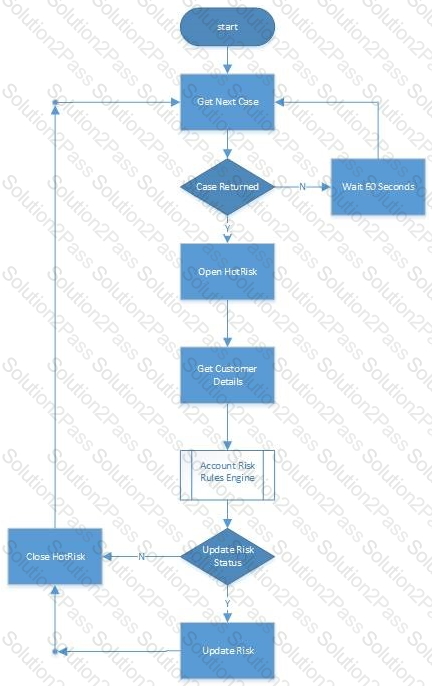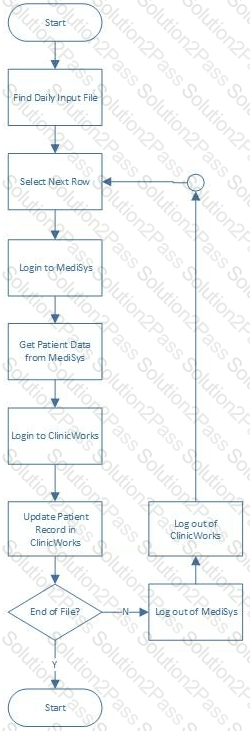ASD01 Blue Prism Designing Blue Prism Process Solutions Free Practice Exam Questions (2025 Updated)
Prepare effectively for your Blue Prism ASD01 Designing Blue Prism Process Solutions certification with our extensive collection of free, high-quality practice questions. Each question is designed to mirror the actual exam format and objectives, complete with comprehensive answers and detailed explanations. Our materials are regularly updated for 2025, ensuring you have the most current resources to build confidence and succeed on your first attempt.
A process is required for a telecoms company to work cases supplied via a daily Excel file. Although the file will only contain around 1000 rows, the average case time is such that the workload is far too big for one machine to complete in a day, so the solution has been designed with multiple machines in mind. One machine will load the work queue while the others wait, then once the queue is ready all machines will work it together. The requirements state that the input file is machine generated, has a known format, is generally clean but may contain exceptions – rows with an empty cell, partial phone numbers, or accounts that don’t exist.
What should the solution do to combat this problem?
Which of the following statement combinations about Blue Prism memory management is correct?
A process definition document has been produced for a process that interfaces with two applications: FirstApp and Customer Information (CI). The process requirement is to perform data extractionfrom FirstApp before performing a number of steps in the CI application.
It is estimated that to perform the daily case volume within SLA’s will require 10 robots. Average case time is approximately 10 minutes, with the FirstApp steps requiring only 1 minute to perform.
The client has a limited number of licenses for the FirstApp application and is reluctant to use 10 of these licenses to automate the process.
Which of the below is a valid design option for the project?
ProSafe credit reference agency retrieves data from bank and other credit providers where customers have missed payments or gone into default. The data isvery sensitive and fed directly into a Blue Prism work queue via a web service. Blue Prism process must process the data within 4 hours. The Blue Prism solution runs continuously and each case takes approximately 30 seconds to process. It is expected thatan average of 10,000 cases per day will be required and up to 10 Blue Prism robots are available. The Blue Prism solution is sown below:

For each case of the process will access the customer account in the HotRisk system and, where an account exists, harvest the data which will be fed along with the Work Queue data into a rules engine. The rules engine is a Blue Prism process that does not interact with any target system. It merely consumes data and, via a complicated series of decision and choice stages, determines the new customer risk factor.
There is to be no scheduler used. Instead the Process Controllers who work in shifts to provide 24 hour support will stop and start process instances in line with Work Queue volumes.
As a Blue Prism process solution designer, who is reviewing the solution, which of the following would concern you? (Choose three.)
Consider the following steps for a theoretical manual process.
Check in input folder any new files.
If there are no files check again later as files can arrive anytime, and there is no limit to the number of files that may come.
Open the next available file.
Take the first case.
Start System X and find the case details.
If the case can’t be found, move to the next one.
After finding the case in System X, fetch additional case details from System Y.
Again if the case can’t be found, move to the next one.
Analyse all the data to see if System Z should be updated.
If the data does not meet the requirements, add notes indicating this to System X and Y and move to the nextcase.
If the data does meet the requirements, update the case in System Z.
Add notes to System X and Y and move to the next case.
At the end of the file, go back and look for another.
Stop checking for new files at 16:00 and finish any remaining cases.
When all work is complete create a report of the day’s exception cases.
Close down Systems X, Y and Z.
It is imperative that notes are applied to System X and Y, regardless of whether System Z is updated or not, what could the process do?(Choose two.)
It’s technically possible for one business object to call another. Outside ofusing utility objects are any of the following valid reasons why you would want to do this?
Consider the following high-level design. Thesolution is intended to read medical data from one application in order to update another. An input file is prepared by an overnight batch run for the solution to work through each morning before patients arrive. Usually the input file is fairly small butat certain times each month the file is much larger.

Which of these options should be considered be the process solution designer to guarantee the quality of the end-to-end solution? (Choose four.)
AnInsurance company has created 4 Blue Prism processes:
1. Change of Address
2. Claims Processing
3. Renewals
4. Order Letter
The Order Letter process is not a published process but is called as a sub process by each of the 3 other processes.
Each day at6am a scheduler starts:
3 instances of the Renewals process on the same virtual machine
2 instances of the Claims Processing process on 2 different virtual machines
1 instance of the Change of Address process on its own virtual machine
How many licenses will be consumed by the running processes?
